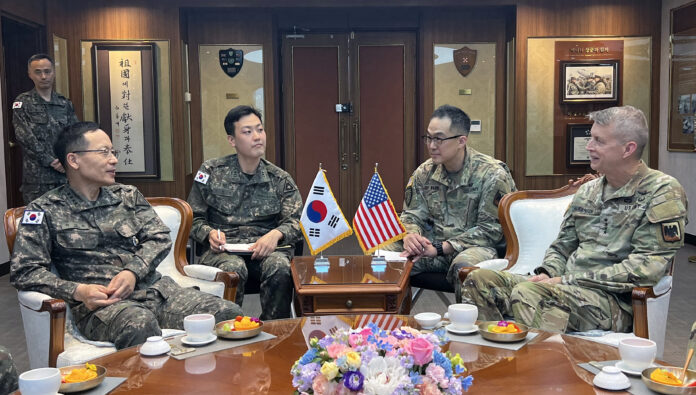Assessing how the National Guard might support U.S. and Republic of Korea forces at a time of deepening U.S. and ROK defense and security ties was top of mind for Army Gen. Daniel Hokanson during a recent visit.
“As a globally proven combat operational reserve with strategic depth, the National Guard is prepared to provide additional support to U.S. Forces Korea, and we can contribute to improving the training and capabilities of Republic of Korea Reserves, if desired,” Hokanson said.
On his first stop on a three-nation Indo-Pacific trip, the National Guard’s most senior general met with senior U.S. and South Korean leaders and visited the demilitarized zone, or DMZ, where he saw firsthand the improved collaboration between U.S. and South Korean forces to maintain the integrity of this key friction point on the Korean Peninsula.
“This alliance is a linchpin of regional stability and has prevented a resumption of hostilities that shredded the post-World War II peace on the Korean Peninsula almost 72 years ago,” Army Gen. Paul LaCamera, commander, U.S. Forces Korea, told a Congressional subcommittee earlier this year.
One of the world’s most heavily guarded borders, the 155-mile DMZ was established in 1953 as a buffer zone between South Korea and North Korea, following the Korean War. A “frozen conflict,” the war ended with an armistice and ceasefire, but no final peace treaty.
The National Guard has played a role in every conflict in U.S. history, and one third of the Army National Guard’s total strength – or six Divisions – mobilized to fight the Korean War. Fully 80% of the Air National Guard mobilized.
Hokanson’s 14-16 May visit followed South Korean President Yoon Suk Yeol’s State Visit to the U.S. in April, at which President Yoon and President Joe Biden commemorated the 70th anniversary of – and strongly affirmed – the U.S.-South Korea Alliance, and agreed on new initiatives to strengthen defense cooperation, increase joint exercises and deepen extended deterrence.
“[O]ur two nations are deepening and broadening all aspects of our relationship at a breakneck speed,” the two presidents said in a joint statement. “The next 70 years of the U.S.-ROK Alliance will be the brightest yet.”
With a population of more than 51 million, South Korea has 500,000 active duty troops and 3.1 million reservists. About 28,500 troops comprise U.S. Forces Korea.
“When desired, the National Guard learns from and shares knowledge with our allies and partners,” Hokanson said. “Uniquely, our combat training and resources mean rapid, unified responses to domestic missions such as natural or manmade disasters or public health emergencies.”
Security cooperation is one of the Guard’s most important missions, Hokanson said, with 100 countries in the 30-year-old Department of Defense National Guard State Partnership Program, including 13 in the Indo-Pacific region.
The National Guard expects to expand the SPP by about 30 more countries, including additional nations in the critically important U.S. Indo-Pacific Command area of responsibility.
“We look forward to helping advance the defense cooperation essential to achieving peace, stability and prosperity in the region,” Hokanson said.
During a visit with Republic of Korea Army Chief of Staff Gen. Park Jeong-Hwan, the two discussed expanding exchanges of reserve forces. The two met at Gyeryongdae, headquarters of the Republic of Korea Army, the first time a CNGB has visited the base.
“We will continue to actively communicate with the National Guard, strengthen the military alliance between the two countries, and seek ways to develop future-oriented forces,” a Republic of Korea Army statement said.
Established in 1968, the ROK Reserve Forces respond to national emergencies, such as armed conflict, crisis, and major disasters. Troops serve 18 months on active duty before joining the reserves.
“Our National Defense Strategy is a call to action to incorporate our allies and partners in all our planning,” Hokanson said. “The National Guard has a proven track record building long-lasting relationships with our allies and partners by consulting and coordinating the modernization of reserve forces and reinforcing existing deterrence capabilities.”
Hokanson serves as the 29th Chief of the National Guard Bureau and as a member of the Joint Chiefs of Staff. In this capacity, he serves as a military adviser to the president, secretary of defense, and National Security Council and is the Defense Department’s official channel of communication to the governors and adjutants general on all matters pertaining to the Guard. He is responsible for ensuring the more than 453,000 Army and Air National Guard personnel are accessible, capable and ready to protect the homeland and provide combat ready resources to the Army and Air Force.




